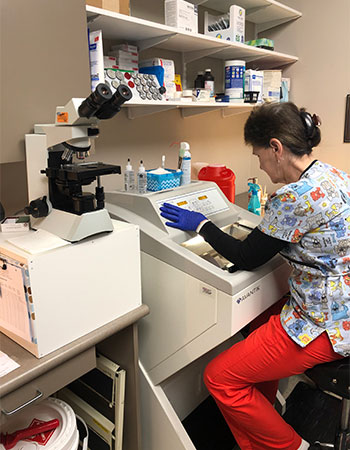Mohs surgery frequently asked questions:
I don't see anything after my biopsy. Do I really need to be treated?
Yes. Following a biopsy, your skin cancer may no longer be visible. However, the surface lesion that was removed can represent the "tip of the iceberg." More tumor cells may remain in the skin. These can continue to grow downward and outward, like roots of a tree. These "roots" are not visible with the naked eye. If they are not removed, the tumor will likely reappear and require more extensive surgery.
Tumors that are neglected can spread deeply into the skin and invade nearby structures. On rare occasions, these cancerous cells can metastasize to lymph nodes and other organs in the body.
Will I be put to sleep for Mohs surgery?
No. The Mohs procedure is performed under local anesthesia on an outpatient basis in an office-based setting.
Will I have a scar after the procedure?
Yes, there will be a scar at the site of the removed skin cancer. The amount of scarring will depend on the size and location of the skin cancer. The Mohs technique minimizes the degree of scarring by limiting the amount of healthy tissue that is removed.
What are the advantages of Mohs micrographic surgery?
The advantages of Mohs include the following:
- The Mohs technique provides the highest cure rate for the treatment of basal cell carcinoma and squamous cell carcinoma. These rates are approximately 99% if Mohs surgery is the initial form of treatment.
- Mohs surgery minimizes the amount of healthy tissue removed so the resulting wound is as small as possible. This decreases the potential for scarring or disfigurement at the site.
- The entire procedure, including cancer removal and reconstruction, is performed in a single outpatient visit under local anesthesia. You will not be put to sleep for the procedure, which results in less potential health risk.
What risks, if any, are associated with Mohs?
Mohs micrographic surgery is usually a well-tolerated procedure; however, as with any surgery there are potential risks. The following potential risks associated with the procedure are considered the exception rather than the rule.
- Infection at the surgical site, which may require an oral antibiotic
- Excessive bleeding during or after surgery
- Scar formation resulting in unsatisfactory cosmetic result
- Poor wound healing
- Allergic reaction to the local anesthetic or other medications
- Damage to nerves resulting in loss of sensation or loss of muscle movement
- Damage to normal tissue surrounding the cancer
How should I prepare for the procedure?

Ways that you can prepare yourself for Mohs surgery can be found below:
- On the morning of surgery, eat a normal breakfast, take all of your regular medications as scheduled, and wear comfortable, loose-fitting clothing.
- Do not apply make-up if the surgery is to be performed on your face.
- If you have been given an antibiotic to take before the surgery, please take it as directed one hour prior to the procedure. Failure to do so could result in the delay or cancellation of the procedure.
- Prepare to spend at least three hours at the office. The procedure may take more time if multiple stages/layers are taken.
- Avoid strenuous exercise, sports activities, heavy lifting, bending, twisting, or straining for at least 1 week following the surgery. Failure to do so may cause bleeding or infection at the surgery site leading to poor healing and an unsatisfactory cosmetic result.
For more information regarding skin cancer and Mohs surgery please visit the American College of Mohs Surgery website.

